![]()
![]()
![]()
Use LEFT and RIGHT arrow keys to navigate between flashcards;
Use UP and DOWN arrow keys to flip the card;
H to show hint;
A reads text to speech;
163 Cards in this Set
- Front
- Back
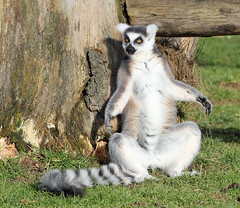
Lemur catta |
Ring-Tailed Lemur Lemur is Latin for 'ghost, spirits of the dead', catta is Latin for 'cat or cat-like' |
|
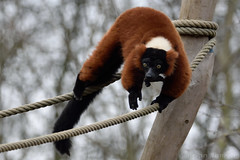
Varecia rubra |
Red Ruffed Lemur Varecia comes from the Malagasy word varika, which refers to lemurs; varika also refers to a mark made on the forehead with charcoal or white earth & used as a charm; rubra is Latin for red, ruddy, painted red |
|

Propithecus verreauxi |
Verreaux's Sifaka Propithecus comes from the Latin 'pro' - before and 'pithecus' - ape, literally meaning 'before ape(s)' or precursor to apes; verrauxi comes from Jules Pierre Verreaux; sifaka is a Malagasy term derived from the threat display made by some sifaka, which is an explosive hiss-like 'shee-fak' sound accompanied by rapid, repetitive backward jerking of the head |
|
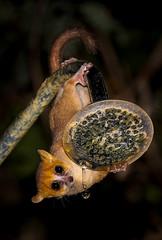
Microcebus myoxinus |
Pygmy Mouse Lemur Microcebus come from the Greek 'mikros' - small and 'kebos' - monkey; the Latin form of 'kebos', 'cebus', is a common suffix for primate names, even when the primates are not monkeys; myoxinus comes from the Greek meaning quick mouse |
|
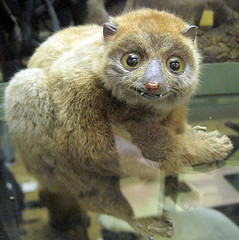
Lepilemur mustelinus |
Weasel Sportive Lemur Lepilemur comes from the Latin 'lepidus' - pleasing, agreeable, and 'lemures' - ghost, spirits of the dead; mustelinus comes from the Latin 'mustela' and '-inus' - weasel |
|
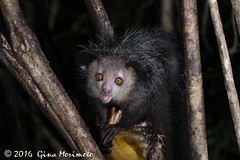
Daubentonia madagascariensis |
Aye-Aye Aye-aye comes from the Malagasy 'heh-heh'; Daubentonia comes from Louis-Jean-Marie Daubenton; madagascariensis refers to Madagascar, where these primates are found |
|

Perodicticus potto |
Potto Potto comes from West African languages' 'potto' - primate; Perodicticus comes from the Latin 'per'- very, and Greek 'deicticos' - indicates |
|
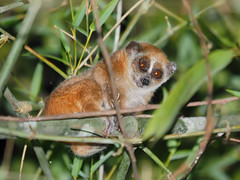
Nycticebus pygmaeus |
Pygmy slow loris Loris comes from the Dutch 'loeris' - clown; Nycticebus comes from the Greek 'nyctis' - night, and Latin 'cebus' - monkey (keep in mind that 'cebus' is a common suffix for primate names, even when the primate is not a monkey); pygmaeus comes from the Latin 'pygmaeus' - dwarf |
|
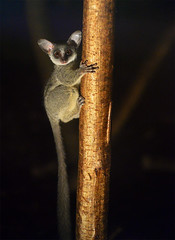
Galago senegalensis |
Senegal bushbaby Galago comes from the Wolof 'golo' - monkey; Senegalensis refers to Senegal |
|

Carlito syrichta |
Philippine tarsier Tarsier comes from the ancient Greek 'ταρσός' ('tarsos') - the flat of the foot; Carlito comes from Carlito Pizarras; syrichta comes from the Greek 'syrich' - screech |
|

Cacajao calvus |
Bald-headed Uacari Uacari comes from the Amazonian languages' 'ouakary' - uacari; Cacajao comes from the Amazonian languages' 'kakáhau' - cacajao; calvus comes from the Latin 'calvus' - bald |
|
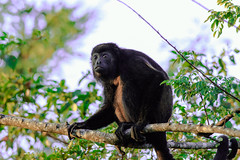
Alouatta palliata |
Mantled Howler Monkey Alouatta comes from the French 'alouate' howler; palliata comes from the Latin 'palliatus' - cloaked (mantle in this case being another word for cloak) |
|
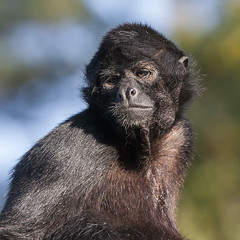
Ateles fusciceps |
Black-headed Spider Monkey Ateles comes from the Greek 'ἀ-' (a-) - no, and 'τελείως' ('teleios') - complete, with a whole meaning of incomplete; fusciceps is Latin for 'dark-headed' |
|
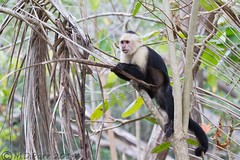
Cebus capuchinus |
White-throated Capuchin Capuchin comes from the Italian 'cappuccio' - hood; Cebus comes from the Latin for monkey, in this case used as a word on its own rather than as a suffix and to name an actual monkey; capuchinus is Latin for hood |
|
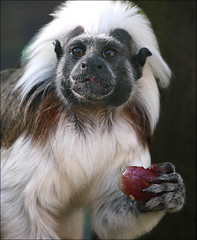
Sanguinus oedipus |
Cottontop tamarin Tamarin comes from the Middle French 'tamary' - tamarin; Saguinus comes from the French 'sagouin' - monkey and Latin '-inus' and means squirrel monkey; Oedipus is Greek for swollen foot and refers to the Greek mythological character Oedipus - Linnaeus named this species and apparently often used names from mythology without particular rationale |
|
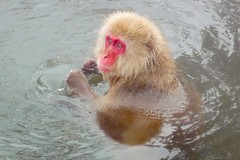
Macaca fuscata |
Japanese macaque Macaque and macaca come from the Old Tupi 'makaka' - monkey; fuscata comes from the Latin 'fuscatus' - darkened |
|
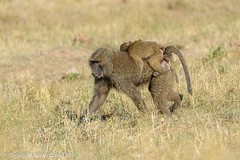
Papio anubis |
Olive baboon Baboon comes from the Old French 'babouin' - grimace; Papio is Latin for 'baboon-like'; anubis come from the Egyptian jackal-headed god Anubis because the baboon's muzzle looks dog-like; the common name comes from the color of the coat, which from a distance appears green-gray |
|
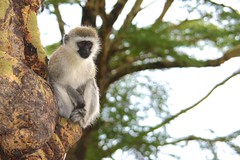
Chlorocebus pygerthrus |
Vervet Monkey Chlorocebus comes from the Greek 'chloro-' - green, and Latin 'cebus' - monkey, literally green monkey; pygerthrus comes from the Greek 'πυγή' ('pygí') and 'ἐρυθρός' ('erythros') - red rump |
|
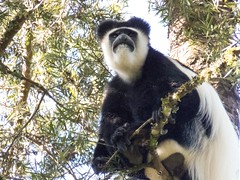
Colobus guereza |
Black-and-white Colobus Monkey Colobus is ancient Greek for mutilated; guereza is the native name of the monkey in Ethiopia |
|
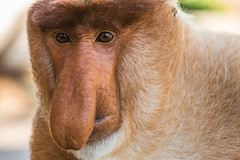
Nasalis larvatus |
Proboscis Monkey Proboscis refers to the nose; Nasalis comes from the Latin 'nasus' and '-alis' - nasal or nose; larvatus is Latin for veiled |
|

Hylobates lar |
White-handed Gibbon Gibbon comes from the French gibbon; Hylobates comes from the Greek 'ὕλη' ('ýli') and 'βαίνω' ('vaíno') - forest walker; lar is Latin for guardian spirit (from Roman myth) |
|
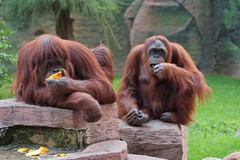
Pongo pygmaeus |
Bornean orangutan Orangutan comes from Malay 'orang' and 'هوتن' - forest man; Pongo comes from the Kongo 'mpongo' - monster; pygmaeus is Latin for dwarf |
|

Gorilla gorilla |
Western Lowland Gorilla Gorilla comes from the Greek 'Γόριλλαι' ('Górillai') - hairy women |
|

Gorilla gorilla berengei |
Mountain gorilla Gorilla comes from the Greek 'Γόριλλαι' ('Górillai') - hairy women; berengei comes from Friedrich Robert von Beringe |
|

Pan troglodytes |
Chimpanzee Chimpanzee comes from Bantu 'ci-mpenzi' - mockman; Pan refers to the Greek god/myth; troglodytes comes from the Latin 'troglodyta' - caveman; Linnaeus originally named chimpanzees Homo troglodytes (cave-dwelling man), recognizing their close relationship to humans. When the distance between chimpanzees and humans was established, they were placed into the genus Pan, but the original scientific species name always travels with an organism even if they change genus or other higher rankings. Therefore, chimpanzees are Pan troglodytes. |
|
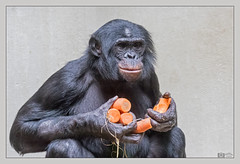
Pan paniscus |
Bonobo Bonobo first appeared in 1954 when Eduard Paul Tratz and Heinz Heck proposed it. It is thought to be a misspelling on a shipping crate from the town of Bolobo on the Congo River. It has also been reported as a word for 'ancestor' in an extinct Bantu language; Pan refers to the Greek god/myth; paniscus means 'little pan greek myth' |
|
|
Paleozoic Era |
Literally "Old Age of Animals"; the oldest of the three Eras within the Phanerozoic Eon, spanning from 544-248 million years ago, composed of six periods: the Cambrian, Ordovician, Silurian, Devonian, Carboniferous, and the Permian |
|
|
Mesozoic Era |
Literally "Middle Age of Animals"; the middle of the three Eras within the Phanerozoic Eon, spanning from 248-65 million years ago, composed of three periods: the Triassic, Jurassic, and Cretaceous |
|
|
Cenozoic Era |
Literally "Recent Age of Animals"; the youngest of the three Eras within the Phanerozoic Eon, and the era within which we live, spanning from 65 million years ago to the present, composed of two periods: the Tertiary and Quaternary |
|
|
Cambrian Period |
Oldest Period in the Paleozoic Era; 542-485 Million years ago; had a massive radiation of complex, multicellular organisms including trilobites (arthropods that resemble seagoing centipedes); the appearance of the first chordates and vertebrates |
|
|
Ordovician Period |
Second Period in the Paleozoic Era; 485-443 million years ago; featured the first appearance of vertebrates with jaws |
|
|
Silurian Period |
Third Period in the Paleozoic Era; 443-419 million years ago; featured the first bony fish and early land plants |
|
|
Devonian Period |
Fourth Period in the Paleozoic Era; 416-359 million years ago; featured the first land vertebrates (tetrapods) |
|
|
Carboniferous Period |
Fifth Period in the Paleozoic Era; 359-299 million years ago; featured the first synapsids (mammal-like reptiles) |
|
|
Permian Period |
Sixth and final Period of the Paleozoic Era; 299-252 million years ago; during this period the continents drifted together near the equator to form the supercontinent Pangaea; ended by the Permian-Triassic extinction event (252.58 million years ago) in which roughly 80% of multicellular species went extinct |
|
|
Triassic Period |
First and oldest Period of the Mesozoic Era; 252-201 million years ago; featured the first dinosaurs and the first true mammals |
|
|
Jurassic Period |
Second Period of the Mesozoic Era; 201-145 million years ago; during this period, Pangaea splits into Laurasia (north) and Gondwana (south); featured the spread of dinosaurs and the first birds |
|
|
Cretaceous Period |
Third and final Period of the Mesozoic Era; 145-66 million years ago; ended by the Cretaceous-Tertiary extinction event - an asteroid impact off the Yucatan Peninsula that caused 85% of land animals to go extinct (including all species over 55 lbs.) |
|
|
Paleogene Period |
First half of the Tertiary Period of the Cenozoic Era; 66-23 million years ago; composed of the Paleocene, Eocene, and Oligocene Epochs |
|
|
Neogene Period |
Second half of the Tertiary Period of the Cenozoic Era; 23-2.6 million years ago; composed of the Miocene and first portion of the Pliocene Epochs |
|
|
Quaternary Period |
Second Period of the Cenozoic Era; 2.6 million years ago - present; composed of the last portion of the Pliocene and the Pleistocene and Holocene Epochs |
|
|
Paleocene Epoch |
First Epoch of the Tertiary Period (also the Paleogene period); 66-56 million years ago; featured early mammalian radiations, and the presence of primates is debated |
|
|
Eocene Epoch |
Second Epoch of the Tertiary Period (also the Paleogene period); 56-34 million years ago; featured the first ungulates, bats, elephants, rodents, whales, and the first true primates |
|
|
Oligocene Epoch |
Third Epoch of the Tertiary Period (also the Paleogene period); 34-23 million years ago; during this epoch, running mammals evolve, as do the first monkeys |
|
|
Miocene Epoch |
Fourth Epoch of the Tertiary Period (also the Neogene period); 23-5.3 million years ago; during this epoch, many modern mammalian families evolve, including the first apes and the first hominins |
|
|
Pliocene Epoch |
Spans the Tertiary and Quaternary Periods; 5.3-2.6 million years ago; many modern mammalian genera evolve, and there is a great diversity in early hominins |
|
|
Pleistocene Epoch |
First full Epoch of the Quaternary Period; 2.6 million years ago-11.7 thousand years ago; features the evolution and spread of the genus Homo and several ice ages |
|
|
Holocene Epoch |
Last and present Epoch of the Quaternary Period; 11.7 thousand years ago-present; features the rise of human civilization and has given rise to the Anthropocene |
|
|
Strepsirrhini |
One of the two major phyletic groups into which primates are divided, a.k.a. the strepsirrhines, composed of the lemurs of Madagascar and the galagos and lorises of Africa and Asia |
|
|
Haplorhini |
One of the two major phyletic groups into which primates are divided, a.k.a the haplorhines, composed of the tarsiers of southeast Asia and the anthropoids (monkeys, apes, and humans) |
|
|
Lemuriformes |
Strepsirrhine prosimian primate infraorder composed of the Lemuridae (lemurs), Indriidae (woolly lemurs, sifakas, and indri), Cheirogaleidae (dwarf and mouse lemurs), Lepilemuridae (sportive lemurs), and Daubentoniidae (aye-aye) |
|
|
Lorisiformes |
Strepsirrhine prosimian primate infraorder composed of the Lorisidae (lorises and pottos) and the Galagidae (galagos/bushbabies) |
|
|
Tarsiiformes |
Haplorhine prosimian primate infraorder composed of the Tarsiidae (tarsiers) |
|
|
Platyrrhini |
Haplorhine anthropoid primate infraorder composed of the Pithecidae (titis, sakis, and uacaris), Atelidae (howling, woolly, and spider monkeys and the muriqis), and Cebidae (capuchin, squirrel, and night monkeys and marmosets and tamarins) |
|
|
Catarrhini |
Haplorhine anthropoid primate infraorder composed of the Cercopithecidae (Old World monkeys), Hylobatidae (gibbons and siamangs), and Hominidae (apes and humans) |
|
|
Lemuridae |
Family composed of the lemurs; part of Infraorder Lemuriformes; strepsirrhine and prosimian |
|
|
Indriidae |
Family composed of the woolly lemurs, sifakas, and indri; part of Infraorder Lemuriformes; strepsirrhine and prosimian |
|
|
Cheirogaleidae |
Family composed of the dwarf and mouse lemurs; part of Infraorder Lemuriformes; strepsirrhine and prosimian |
|
|
Lepilemuridae |
Family composed of the sportive lemurs; part of Infraorder Lemuriformes; strepsirrhine and prosimian |
|
|
Daubentoniidae |
Family composed of the aye-ayes; part of Infraorder Lemuriformes; strepsirrhine and prosimian |
|
|
Lorisidae |
Family composed of the lorises and pottos; part of Infraorder Lorisiformes; strepsirrhine and prosimian |
|
|
Galagidae |
Family composed of the galagos (bushbabies); part of Infraorder Lorisiformes; strepsirrhine and prosimian |
|
|
Tarsiidae |
Family composed of the tarsiers; part of Infraorder Tarsiiformes; haplorhine and prosimian |
|
|
Pithecidae |
Family composed of the titis, sakis, and uacaris; part of Infraorder Platyrrhini; haplorhine and anthropoid |
|
|
Atelidae |
Family composed of the howling, woolly, and spider monkeys and the muriquis; part of Infraorder Platyrrhini; haplorhine and anthropoid |
|
|
Cebidae |
Family composed of the capuchin, squirrel, and night monkeys and the marmosets and tamarins; part of Infraorder Platyrrhini; haplorhine and anthropoid |
|
|
Cercopithecidae |
Family composed of the Old World monkeys; part of Infraorder Catarrhini; haplorhine and anthropoid |
|
|
Hylobatidae |
Family composed of the gibbons and siamangs; part of Infraorder Catarrhini; haplorhine and anthropoid |
|
|
Hominidae |
Family composed of the apes and humans; part of Infraorder Catarrhini; haplorhine and anthropoid |
|
|
plesiadapiforms |
Mammalian order or suborder of mammals that may be ancestral to later Primates, characterized by some but not all of the primate trends (low, flat skull with small braincase and long snout; no post-orbital bar or closure; projecting incisors followed by a diastema; earliest had a 3-1-3-3 dental formula but later forms show a reduction; sharp tooth cusps and small size suggest most were insectivores; postcrania suggest they were arboreal); very abundant during the Paleocene Epoch (66-56 million years ago) and the early Eocene Epoch in what is now North America, Europe, and Asia |
|
|
omomyiforms |
One of two types of primates of modern aspect; tarsier-like; either ancestors of modern haplorhines or ancestors of modern tarsiiformes; found in North America, Europe, Asia, and possibly Africa; possess ear tubes, large eyes, a short snout, large incisors, small canines, and elongated tarsus and the small species possess sharp pointed molar cusps while larger later species have flat molar teeth; representative genera: Teilhardina, Altanius, Necrolemur, Rooneyia, Shoshonius, and Ekgmowechashala |
|
|
adapiforms |
One of two types of primates of modern aspect; lemur-like; ancestors of modern Strepsirrhines; found in North America, Europe, Asia, and Africa; possess a ring in the ear, small eyes, a long snout, small incisors, large canines, many premolar and molar shearing crests, and digital nails; representative genera: Darwinius, Notharctus, Smilodectes, Adapis, Cantius, and Europolemur |
|
|
Purgatorius |
Plesiadapid (possible early primate) genus living in what is now Montana during the Paleocene Epoch (66-56 million years ago); generalized enough to have given rise to the first clear primates that appear in the fossil record of the Eocene |
|
|
Darwinius |
Darwinius masillae; Representative adapiform genera found near Messel, Germany, in 1983 by a private collector. It is the most complete fossil primate ever found, but it was not examined by scientists until the mid-2000s. It dates to 47 million years old and has been nicknamed "Ida". Some have suggested that it may be ancestral to anthropoids, but most think it is simply an adapiform. |
|
|
Eosimias |
Eocene Anthropoid that is possibly the earliest anthropoid (45-40 million years ago), possessing a calcaneus that is intermediate to those of a tarsier and a baboon, but closer to that of the baboon |
|
|
Qatrania |
Eocene early anthropoid (35 million years ago) found in the Fayum Basin, Egypt |
|
|
Biretia |
Eocene early anthropoid (37 million years ago) found in the Fayum Basin, Egypt |
|
|
Aegyptopithecus |
Oligocene early catarrhine (30 million years ago) found in the Fayum Basin, Egypt |
|
|
Branisella |
Oligocene early platyrrhine (26 million years ago) found in Salla, Bolivia possessing molars with low, rounded cusps |
|
|
Proconsul |
Early to middle Miocene primitive ape (23-16 million years ago); found in several locations around Lake Victoria, Kenya; weighed between 17-50 kg and had a cranial capacity of 167 cubic cm; had ape-like cranium and teeth, Y-5 molars, monkey-like postcranium, and no tail |
|
|
Dryopithecus |
Middle to late Miocene primitive ape (12-10 million years ago); found in Europe; weighed between 20-35 kg; had a Y-5 molar pattern, no tail, a broad interorbital distance, and a modern ape postcranium, including definitive evidence of suspensory locomotion |
|
|
Sivapithecus |
Middle to late Miocene primitive ape (12-6 million years ago); found in the Siwalik Hills of India and Pakistan; weighed between 40-90 kg; had a Y-5 molar pattern, a narrow interorbital distance, and the postcranium shows some characteristics that suggest suspensory locomotion and others that suggest arboreal quadrupedalism |
|
|
Gigantopithecus |
Late Miocene primitive ape (6.5 million years ago); found in India, Pakistan, and China; weighed between 190-225 kg; huge, but only known from its mandibles and teeth, which follow a Y-5 molar pattern |
|
|
primatology |
The study of non-human primates |
|
|
primate paleontology |
The study of the primate fossil record |
|
|
taxonomic ranks |
The hierarchical levels of classification (Kingdom, Phylum, class, order, family, genus, species, etc.) |
|
|
homology |
A shared trait that was present in a common ancestor (such as the number and order of the bones of the arm) |
|
|
homoplasy |
A shared trait that was not present in a common ancestor (such as wings, a.k.a. analagous structures) |
|
|
plesiomorphy |
A primitive trait (shared with other groups - such as generalized skeletal structure, heterodonty, hair, long gestations followed by live birth, endothermy, and increased brain size - traits shared with other mammals) |
|
|
apomorphy |
A derived trait (unique to a particular group - such as the modification of the hands and feet for manipulation and grasping, the reorganization of the senses (increased vision and reduced olfaction), and the very high level of complex behavior (especially learned behavior) unique to primates) |
|
|
tetrapod |
Having four legs/limbs (from the Greek 'tetra' - four and 'podia' - feet) |
|
|
pentadactyl |
Having five rays on the hands and feet (from the Greek 'penta' - five and 'dactyl' - finger, digit) |
|
|
heterodonty |
Having different types of teeth (from the Greek 'hetero' - different and 'donti' - teeth) |
|
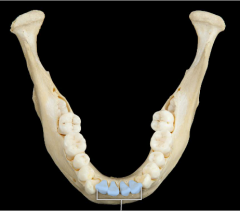
incisors |
The spatulate teeth in the front of the upper and lower jaws used for nibbling and cutting |
|
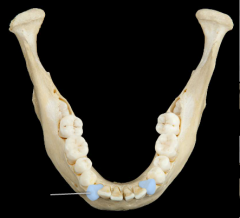
canines |
Conical biting and tearing teeth next to the incisors in the upper and lower jaws used for stabbing |
|
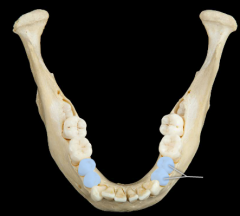
premolars |
Teeth intermediate in form between biting, grasping, shearing, and grinding, behind the canines in the upper and lower jaw |
|
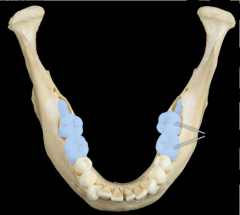
molars |
Large teeth at the back of the upper and lower jaws whose extensive chewing surfaces emphasize crushing and grinding rather than shearing of food |
|
|
dental formula |
The number and arrangement of the teeth in the dental arcade (jaw) |
|
|
r-selected |
Produce many offspring (the majority of which are unlikely to survive to adulthood - think of sea turtles and mice) |
|
|
K-selected |
Invest heavily in few offspring (the majority of have a good chance of surviving to adulthood - think of whales, elephants, and primates) |
|
|
endothermy |
The ability to produce heat internally, but the organism must maintain a body temperature within a narrow range and excess heat must be dissipated to prevent overheating |
|
|
opposable hallux |
The opposable big toe present in many primates (hallux means big toe, and is the pair to the thumb on the foot) |
|
|
nails |
One of the modifications of primate hands and feet for manipulation, changing the ends of the digits to flat, broad phalanges with nails growing out of the back instead of the sharp pointed phalanges that many other mammals possess. |
|
|
binocular vision |
Overlapping fields of vision |
|
|
stereoscopic vision |
The ability to perceive objects in three dimensions (gives depth perception) |
|
|
post-orbital bar |
A bony ring encircling the lateral side of the eye but not forming a complete cup around the eye globe |
|
|
post-orbital closure |
The complete enclosure of the lateral side of the eye, forming a complete cup around the eye globe |
|
|
arboreal hypothesis |
Hypothesis for the origin of primate adaptation that focuses on the value of grasping hands and stereoscopic vision for life in the trees; primates evolved to fill an arboreal niche |
|
|
visual predation hypothesis |
Hypothesis for the origin of primate adaptation that focuses on the value of grasping hands and stereoscopic vision for catching small prey; primates adapted to shrubby forest undergrowth and hunted insects and other small prey |
|
|
folivory |
Leaf-eating, characterized by narrow incisors and shearing molar crests |
|
|
frugivory |
Fruit-eating, characterized by spatulate incisors, molariform premolars, and low, rounded molar cusps (bunodont) |
|
|
insectivory |
Insect-eating, characterized by sharp, pointy incisors and canines and high-crested, high-pointed molar cusps |
|
|
gummivory |
Gum-eating, characterized by stout, pointy incisors |
|
|
Kay's Threshold |
A weight threshold (boundary) of 500g. Below this weight, there are no leaf specialists (no primates that rely primarily on leaves for their diet). Above this weight, there are no insect specialists (no primates that rely primarily on insects for their diet). |
|
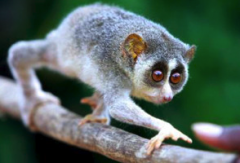
pronograde |
Horizontal back posture (locomotion is primarily parallel to the ground) |
|
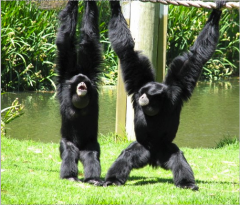
orthograde |
Vertical back posture (locomotion is primarily perpendicular to the ground) |
|
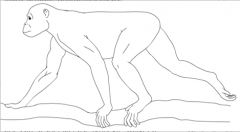
arboreal quadrupedalism |
The most common form of locomotion in primates; found in many primates from many groups. Characterized by pronograde posture; a long olecranon process; a deep ulna; laterally placed scapulae; a narrow thorax; grasping feet; short, similar-length forelimbs and hindlimbs; and a long tail |
|
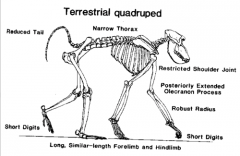
terrestrial quadrupedalism |
Found in one lemur species (Lemur catta), and many Old World monkeys. African apes are a special case (knuckle-walkers). Characterized by pronograde posture; a restricted shoulder joint; a posteriorly extended olecranon process; robust radii (plural of radius); short digits; long, similar-length forelimbs and hindlimbs; a narrow thorax; and a reduced tail. |
|
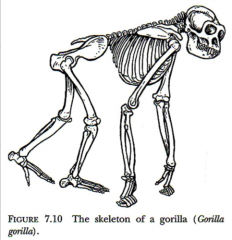
knuckle-walking |
Modern African apes (chimpanzees and gorillas) use a form of terrestrial quadrupedalism called knuckle-walking, in which they fold the manual (hand) phalanges under and walk on the back of the middle phalanges. |
|
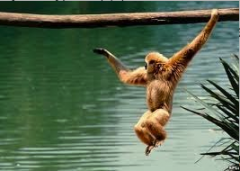
arm swinging/brachiation |
Common in gibbons, siamangs, and spider monkeys. Characterized by orthograde posture, long curved fingers, a rotary wrist joint, long forelimbs, a short olecranon process, dorsally placed scapulae, a broad thorax, a short lumbar region, often no tail, and a mobile hip joint. |
|
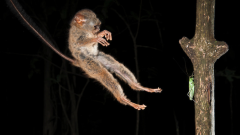
leaping |
Common in sifakas, indri, and tarsiers. Characterized by orthograde posture, deep femoral condyles, long hindlimbs, narrow tibiae, a long lumbar region, and short femoral necks |
|
|
diurnal |
Active during the day; characterized by: cons: decreased olfaction, increased predation, possible heat stress, and food competition with birds and other primates; pros: better visual foraging and better visual communication |
|
|
nocturnal |
Active during the night; characterized by: cons: reduced social communication and reduced foraging ability; pros: decreased food competition, decreased heat stress, decreased predation, and enhanced olfaction |
|
|
solitary |
Species which normally feed and travel alone, but they can still have complex interactions with other individuals of the same species. Many of the nocturnal primates and some of the diurnal primates are solitary. |
|
|
gregarious |
Species which normally feed and travel in groups. Most of the diurnal primates and some of the nocturnal primates are gregarious. |
|
|
binomial nomenclature |
The two-word system of naming species using both the genus and species terms (for example, Homo sapiens) |
|
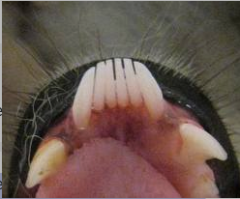
tooth comb |
Feature of strepsirrhine anatomy in which the lower incisors and canines form a long, protruding, comb-like structure |
|
|
grooming claw |
Feature of strepsirrhine anatomy in which the second digit of the feet possesses a claw rather than a nail, used for grooming |
|
|
rhinarium |
Literally, 'wet nose', the wet, naked skin surrounding the openings of the nostrils in most mammals; a feature of strepsirrhine anatomy |
|
|
tapetum lucidum |
Literally, 'tapestry of light'; a biological reflector system which functions to provide the light-sensitive retinal cells with a second opportunity for photon-photoreceptor stimulation, enhancing visual sensitivity at low light levels; a feature of strepsirrhine anatomy |
|
|
fused/unfused frontal |
An unfused frontal (forehead) bone is a feature of strepsirrhine anatomy; a fused frontal is a feature of haplorhine anatomy |
|
|
fused/unfused mandibular symphysis |
An unfused mandibular symphysis (lower jaw) is a feature of strepsirrhine anatomy a fused mandibular symphysis is a feature of haplorhine anatomy |
|
|
Malagasy |
Means 'from Madagascar'. A member of the Malayo-Polynesian branch of the Austronesian language family spoken by about 17 million people in Madagascar, Comoros, Réunion, and Mayotte. |
|
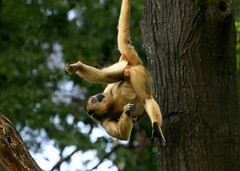
prehensile tail |
Grasping tail possessed by some species of the primate families Cebidae and Atelidae |
|
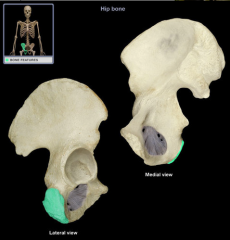
ischial tuberosities |
Protrusions of the ischial bone in the pelvis; Catarrhines tend to have expanded ischial tuberosities and well-developed sitting pads (not found in some apes) |
|

biolophondont molars |
Feature of Old World Monkeys; Molars that have four cusps oriented in two parallel rows, resembling ridges or 'lophs' |
|
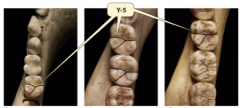
Y-5 molars |
Feature of Hominoids; Molars that have five cusps with grooves running between them, forming a Y shape. |
|
|
extant ape features |
remodeled shoulder girdle; broad thorax; reduced deep back muscles; short lumbar region; long, straight forelimb; increased supination; no tail; elongated curved fingers |
|
|
fossils |
The preserved remains of once-living things |
|
|
trace fossils |
Fossilized impressions of once-living things |
|
|
coprolite |
Fossilized feces (poop) |
|
|
taphonomy |
The study of what happens to the remains of an organism from the time of death to the time of discovery |
|
|
taphonomic stages |
Death, Decomposition, Burial, and Fossilization |
|
|
diagenesis |
Mineralization of organic matter |
|
|
relative dating techniques |
Can only state whether something is older or younger than something else; examples: biostratigraphy and paleomagnetism |
|
|
absolute dating techniques |
Rely on radioactivity, which provides a clockwork amount of decay via radioactive half-lives; examples: potassium-argon (K-Ar) dating, radiocarbon dating (carbon-14), uranium series dating |
|
|
isotope |
One of two or more atoms having the same atomic number but different mass numbers (i.e., different numbers of neutrons) |
|
|
half-life |
The amount of time it takes for half of a radioactive isotope to decay into a stable isotope |
|
|
biostratigraphy |
Relative dating technique using comparison of fossils from different stratigraphic sequences to estimate which layers are older and which are younger |
|
|
paleomagnetism |
Relative dating technique using the record of the Earth's magnetic field in rocks, sediment, or archaeological materials. The magnetic field can reverse direction (magnetic north switches to the South Pole and vice versa), and certain minerals in rocks lock-in a record of the direction and intensity of the magnetic field when they form. This can be used to relatively date fossils found in rocks of either normal or reversed polarity. |
|
|
potassium-argon dating |
Radiometric (absolute) dating technique using the decay of potassium (K) 40 to Argon (Ar) 40 in potassium-bearing rocks; estimates the age of sediments in which fossils are found. Dating range from 4.5 billion years ago to recent; can be used to date Potassium-bearing minerals and glass |
|
|
radiocarbon dating |
Radiometric (absolute) dating technique that uses the decay of carbon-14 in organic remains such as wood and bone to estimate the time since the death of the organism; Dating range from 40,000 years ago to recent; can be used to date organic (carbon-bearing) materials such as wood, bone, and shell |
|
|
uranium series dating |
Radiometric (absolute) dating techniques using the decay of uranium to estimate an age for calcium carbonates including flowstones, shells, and teeth; Dating range from 500,000 years to thousands of years ago, depending on the material; can be used to date Uranium-bearing minerals, CaCo3, flowstones, corals, shells, and teeth |
|
|
thermoluminescence |
Radiometric (absolute) dating electron trap technique that uses heat to measure the amount of radioactivity accumulated by a specimen, such as a stone tool, since its last heating; Dating range from 500,000 to 100,000 years ago, depending on the material; can be used to date quartz, feldspar, pottery, and stone tools |
|
|
electron spin resonance |
Dating range typically to 500,000 years ago and pssibly to a few million years ago, depending on the material; can be used to date Uranium-bearing materials in which uranium has been taken up from external sources |
|
|
geological column |
The overall sequence of the rocks of the earth throughout its history |
|
|
Cretacious-Paleogene extinction event |
An asteroid impact off the coast of the Yucatan Peninsula which caused 85% of land animals to go extinct (inclusing all species over 55 lbs.); Same thing as the Cretacious-Tertiary extinction event |
|
|
multituberculates |
Rodent-like mammals present during the Paleocene Epoch (66-56 million years ago) |
|
|
pantodonts |
The largest land mammals (cow-sized herbivores) present during the Paleocene Epoch (66-56 million years ago) |
|
|
Gastornis |
A large, flightless bird present during the Paleocene Epoch (66-56 million years ago) |
|
|
Grande Coupure |
Major extinction event that began the Oligocene Epoch (34 million years ago) due to sudden cooling of the earth; literally, "big cut" |
|
|
hominin |
The group of primates consisting of modern humans, extinct human species, and all our immediate ancestors, including members of the genera Homo, Australopithecus, Paranthropus, and Ardipithecus |
|
|
interorbital distance |
The distance between the two orbits of the eyes (eye sockets), measured from the junction of the lacrimal bone, the frontal process of the maxilla, and the frontal bone. |

